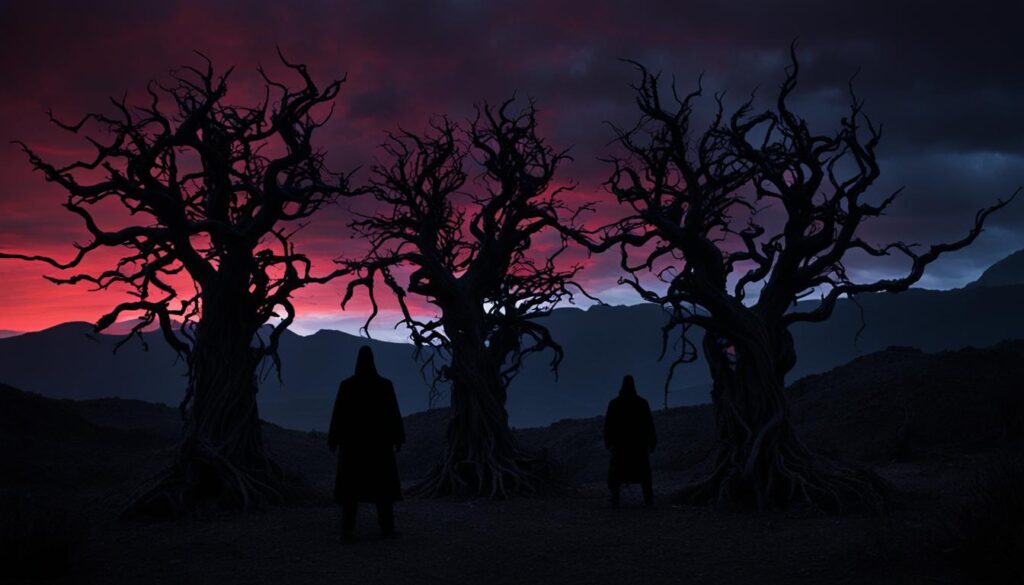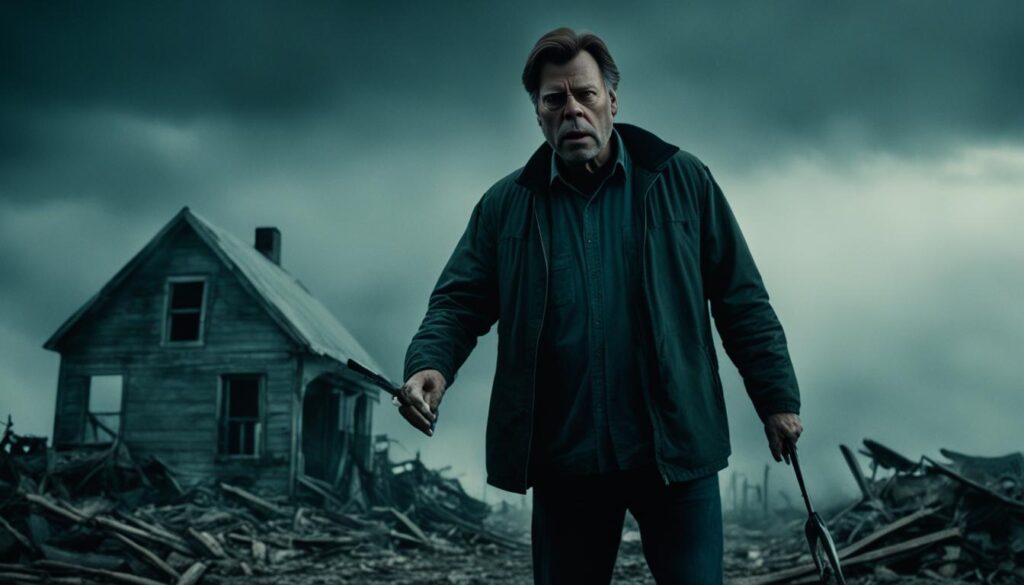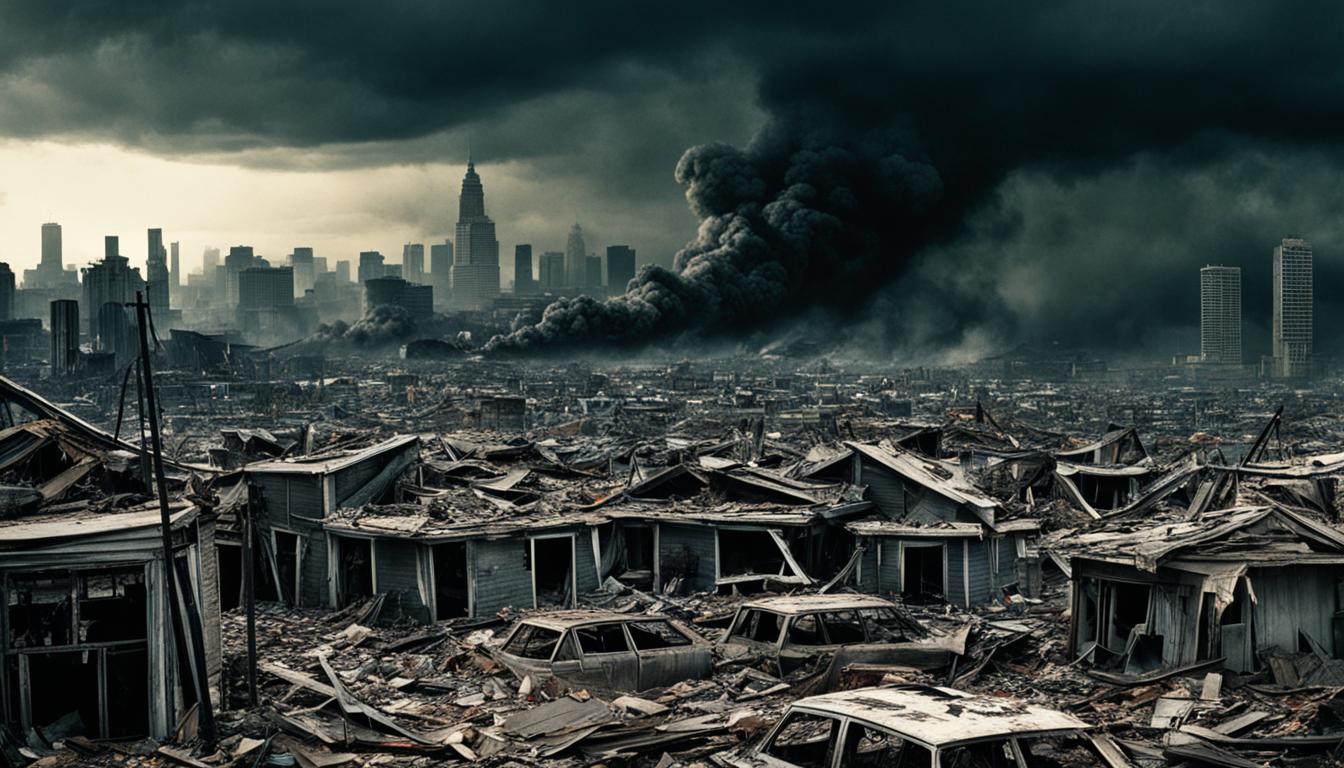If you’re a fan of post-apocalyptic tales, then “The Stand” by Stephen King is a must-read novel for you. This book weaves a story of chaos, destruction, and survival, as a deadly pandemic wipes out most of the world’s population. As the story unfolds, we witness a battle between good and evil, with the fate of the remaining survivors hanging in the balance.
In this article, we’ll provide a summary of “The Stand,” exploring its themes, characters, and symbolism, as well as the critical reception it has garnered since its release. We’ll also discuss the various adaptations of the novel, both on-screen and off, and offer our own final thoughts on its significance and impact.
Key Takeaways:
- “The Stand” is a post-apocalyptic novel by Stephen King
- The story revolves around a pandemic that wipes out most of the world’s population
- The novel explores themes of good versus evil and the representation of supernatural forces
- “The Stand” has garnered critical acclaim and has been adapted into various mediums
- Overall, “The Stand” is a must-read for fans of the post-apocalyptic genre
Introduction to “The Stand”
Stephen King’s “The Stand” is a post-apocalyptic novel that explores the aftermath of a superflu pandemic that has decimated the population. In this epic tale, the survivors must navigate a hostile landscape and confront their inner demons and the forces of evil that have emerged in the wake of the pandemic. The story begins with the outbreak of the pandemic, which kills off 99% of the population, leaving behind a scattered group of survivors struggling to make sense of the catastrophic event.
The opening pages of the novel introduce us to a diverse cast of characters, whose lives will intersect in unpredictable ways as the story progresses. The main protagonist, Stu Redman, is a blue-collar worker from Texas who is immune to the virus and is recruited by the government to participate in a secret project. Meanwhile, in Las Vegas, a charismatic but wicked figure named Randall Flagg has begun to amass a cult of followers intent on creating a new order out of the chaos.
As the survivors begin to band together and form communities, they must confront the reality of their situation and the challenges of rebuilding in a world that has been turned upside down. From the search for a cure to the battle for control between the forces of good and evil, “The Stand” takes us on a journey of survival, redemption, and hope in the face of overwhelming adversity.
The Protagonists of “The Stand”
“The Stand” features an ensemble cast of characters who rise to the occasion as the survivors of a devastating virus outbreak. At the heart of the story are the main protagonists who band together to face a common enemy.
Stu Redman
Stu is an easygoing everyman who finds himself immune to the virus that wipes out most of humanity. As one of the few survivors, he becomes a reluctant hero who takes on a leadership role in the fight against the forces of darkness.
Larry Underwood
Larry is a struggling musician whose life takes a turn for the worse when the pandemic strikes. He eventually finds his way to Stu and the rest of the group and becomes an essential member of their community.
Nick Andros
Nick is a young deaf man who has honed his other senses to compensate for his disability. He crosses paths with other survivors and grows to be a trusted ally in the battle against evil.
Tom Cullen
Tom is a slow-witted but kind-hearted man who forms a strong bond with Nick. Despite his limitations, Tom proves to be an essential member of the group thanks to his simple but unwavering loyalty.
Frannie Goldsmith
Frannie is a young, pregnant woman who befriends Stu early on in the story. Together, they navigate the dangers of a world that has been turned upside down by the virus.
Abigail Freemantle
Abigail is an elderly woman also immune to the virus who acts as a spiritual guide to the group. She possesses supernatural powers and serves as a beacon of hope for the survivors fighting against the darkness.
Together, these protagonists and others play integral roles in the story of “The Stand,” forming alliances, facing adversity, and struggling to survive in a world that has been irrevocably changed.
The Antagonists of “The Stand”
“The Stand” presents a world decimated by a fatal pandemic, leaving behind a handful of survivors fighting for survival amidst chaos and despair. However, among these survivors are those who thrive on the chaos, worsen the despair, and spread darkness. These individuals serve as the antagonists of the story, opposing the main protagonists in their quest for a better world.
Randall Flagg
The most prominent of these antagonists is Randall Flagg, also known as the “Walkin’ Dude,” a demonic figure who displays supernatural powers and appears to be immortal. He leads a cult of fanatically loyal followers, bent on destruction, chaos, and violence. Flagg embodies evil in its purest form and poses a significant threat to the protagonists’ mission of rebuilding society.
Nadine Cross
Nadine Cross is another significant antagonist in “The Stand.” She initially appears as a victim of circumstance, a survivor trying to make sense of the new world around her. However, as the story progresses, it becomes clear that Nadine is in league with Flagg, serving him and his cult in a loyal and dangerous capacity.
Harold Lauder
Harold Lauder is a complex character that transitions from victim to antagonist over the course of the story. His childhood traumas and unrequited love fuel his resentment towards the world, and his eventual alliance with Flagg further deepens his depravity.

The actions of these antagonists serve as a constant source of tension and conflict throughout the novel, adding depth to the narrative and highlighting the consequences of unchecked evil in a post-apocalyptic world.
The Journey of the Survivors
Following the deadly pandemic that spreads across the United States in “The Stand,” the remaining survivors face a perilous journey in their quest for survival. They navigate a harsh and dangerous landscape, fighting hunger, thirst, and exposure to the elements, while evading hostile groups and scavengers.
Despite numerous challenges, the survivors form alliances and develop a sense of community. They build new societies and elect leaders, but also face internal conflicts and power struggles. Along the way, they encounter significant events that shape their journey and bring them closer to the ultimate confrontation between good and evil.
The Formation of Communities
In their journey, the survivors come together to form new societies that offer safety and protection. One such example is the Free Zone in Boulder, Colorado, led by Mother Abagail, a benevolent and spiritual figure who attracts a group of survivors with her visions. In contrast, the antagonist Randall Flagg creates a despotic society in Las Vegas, centered on fear and control.
The Role of Hope
Throughout their journey, the survivors keep the hope for a better future alive. Their sense of purpose and desire to rebuild society drives them forward and helps them overcome the challenges they face. This hope is especially evident in the character of Stu Redman, who embodies optimism and determination despite the dire circumstances.
The Final Confrontation
The journey of the survivors culminates in the ultimate showdown between good and evil. The forces of Mother Abagail and Randall Flagg clash in a final battle that decides the fate of humanity. The conflict represents themes of free will versus destiny, and the power of collective action to overcome adversity.
- The journey of the survivors in “The Stand” is marked by perseverance and resilience in the face of adversity.
- They form communities and find hope even in the darkest moments.
- The final confrontation highlights the themes of free will and destiny, and the importance of collective action.
Themes and Symbolism in “The Stand”
Stephen King’s “The Stand” explores various themes and employs symbolism to take readers on a journey that extends beyond a mere post-apocalyptic setting. The novel highlights the struggle between good and evil, depicting the impact of morality in shaping the direction of humanity’s choices and actions.
One of the central themes explored in “The Stand” is the nature of humanity. Through the characters’ struggles, the novel demonstrates the dark aspects of human nature and the capacity to commit terrible acts in desperate times. However, it also explores the resilience and the will to survive, embodying the message of hope in the face of adversity.
Religious and supernatural elements are present in the story, with characters grappling with faith, redemption, and the idea of divine intervention. However, the representation of these elements is not one-dimensional, as King often subverts and challenges traditional beliefs and expectations.
The symbolism in “The Stand” contributes to its allegorical nature, aiding and reinforcing the themes explored. From the prophetic dreams of Mother Abagail to the ominous presence of Randall Flagg, the metaphorical significance of the characters and their actions cannot be understated.
Overall, the themes and symbolism in “The Stand” elevate it beyond a standard post-apocalyptic tale, and the novel’s enduring appeal lies in its ability to engage readers on both an intellectual and emotional level.
Stephen King’s Writing Style in “The Stand”
Stephen King is recognized for his ability to craft vivid characters and paint rich landscapes through his writing. His unique storytelling style is on full display in “The Stand,” where he masterfully weaves together elements of horror, fantasy, and humanity to create a compelling narrative.
King’s use of language in “The Stand” is engaging and immersive, drawing readers into the post-apocalyptic world he has created. He employs descriptive phrases and metaphors that vividly depict the decaying world around the characters, making it feel almost palpable.
King’s characters are multi-dimensional and relatable, with flaws and quirks that add depth to their personalities. Through their interactions and relationships, readers are given insights into the human condition, making the story all the more impactful. The pacing of the story is also expertly handled, shifting between moments of action and contemplative reflection to keep readers fully invested.
Overall, Stephen King’s writing style in “The Stand” sets a high standard for storytelling, showcasing his mastery of character development, language, and pacing.

Critical Reception and Legacy of “The Stand”
“The Stand” has received widespread critical acclaim since its initial publication in 1978. The novel has been praised for its intricate plot, well-developed characters, and exploration of complex themes.
Many literary critics consider “The Stand” to be one of Stephen King’s most impressive works. The New York Times Book Review hailed it as a “masterpiece” and praised King for his skill in creating a “fully realized, apocalyptic world.” The Washington Post described the novel as “epic” and “complex,” noting its ability to tackle weighty issues while still delivering on suspense and thrills.
“The Stand” has also had a lasting impact on the post-apocalyptic genre, influencing the works of other writers and filmmakers. The novel paved the way for an entire genre of literature and has become a cornerstone of pop culture.
The legacy of “The Stand” continues to endure, with numerous adaptations across different mediums. In 1994, a popular television miniseries based on the novel was released, capturing the attention of audiences around the world. In 2020, a new adaptation was released, bringing King’s epic tale to a new generation of fans.
Overall, “The Stand” remains a powerful and memorable work of fiction, with its critical reception and impressive legacy firmly cementing it as one of King’s greatest achievements.
Adaptations of “The Stand”
Stephen King’s epic novel has been the subject of several adaptations over the years, with mixed results. In 1994, a miniseries adaptation was released, featuring an all-star cast and closely following the plot of the book. The miniseries was generally well-received, though some fans felt that certain elements of the story were lost or diluted in the translation to the screen.
In 2020, a new television series adaptation of “The Stand” was released, with a more modernized take on the story and an updated cast of actors. This adaptation was met with mixed reviews, with some praising its faithfulness to the source material and others criticizing its deviations and weaker performances.
Regardless of the differing opinions on each adaptation, the challenges of adapting a story as complex and sprawling as “The Stand” are clear. From the intricate character arcs to the complex mythology and themes, it takes careful consideration and skillful execution to translate King’s vision onto the screen.
Conclusion and Final Thoughts on “The Stand”
“The Stand” by Stephen King is an epic tale that has stood the test of time. Through its exploration of good and evil, the nature of humanity, and the representation of religious and supernatural elements, the novel has captivated readers for decades.
King’s writing style is masterful, with his use of language, character development, and pacing all contributing to the immersive experience of the story. “The Stand” has influenced the post-apocalyptic genre and continues to garner praise from both readers and critics alike.
Despite being a challenging story to adapt, “The Stand” has been successfully translated onto both the big and small screens, with various adaptations demonstrating the enduring legacy of the novel.
In conclusion, “The Stand” is a timeless masterpiece that showcases Stephen King’s talent as a storyteller. Its themes, characters, and plot continue to resonate with readers today, cementing its place in the literary canon.
Our final thoughts on “The Stand” are that it is a must-read for anyone who loves immersive storytelling, post-apocalyptic fiction, or simply a good versus evil showdown.
FAQ
What is "The Stand" by Stephen King about?
“The Stand” is a post-apocalyptic novel by Stephen King that tells the gripping story of a devastating pandemic that wipes out most of the world’s population. It explores the struggle between good and evil in a world thrown into chaos.
Who are the main characters in "The Stand"?
The main characters in “The Stand” are a diverse group of survivors who possess unique backgrounds, motivations, and special abilities. They come together to form a core group fighting against the forces of evil in the post-apocalyptic world.
Who are the antagonistic forces in "The Stand"?
The antagonists in “The Stand” are the main villains who employ various methods to spread chaos and control the remaining survivors. They pose significant threats to the protagonists and play a critical role in the overarching conflict of the story.
What is the journey of the survivors in "The Stand"?
The survivors in “The Stand” embark on a perilous journey through the post-apocalyptic landscape. They face numerous challenges, form alliances, and encounter conflicts that ultimately lead them to a confrontation between the forces of good and evil.
What are the themes and symbolism explored in "The Stand"?
“The Stand” delves into themes such as good versus evil, the nature of humanity, and the presence of religious and supernatural elements. The novel incorporates symbolic representations to enhance the depth and meaning of the narrative.
What is Stephen King’s writing style in "The Stand"?
In “The Stand,” Stephen King showcases his unique writing style characterized by vivid language, in-depth character development, and a well-paced narrative. His ability to create a captivating and immersive story is on full display in this novel.
How has "The Stand" been critically received and what is its legacy?
“The Stand” has received critical acclaim and has had a lasting impact on the post-apocalyptic genre. It is widely regarded as one of Stephen King’s most significant works, praised for its compelling storytelling and exploration of complex themes.
Have there been any adaptations of "The Stand"?
“The Stand” has been adapted into various mediums, including film and television. These adaptations have faced unique challenges in translating the complex story onto the screen but have also garnered significant attention and a dedicated fan base.
What are the concluding thoughts on "The Stand"?
“The Stand” by Stephen King is a timeless and gripping narrative that brings readers into a post-apocalyptic world filled with memorable characters, intense conflicts, and thought-provoking themes. It is a testament to King’s storytelling prowess and continues to captivate audiences today.



